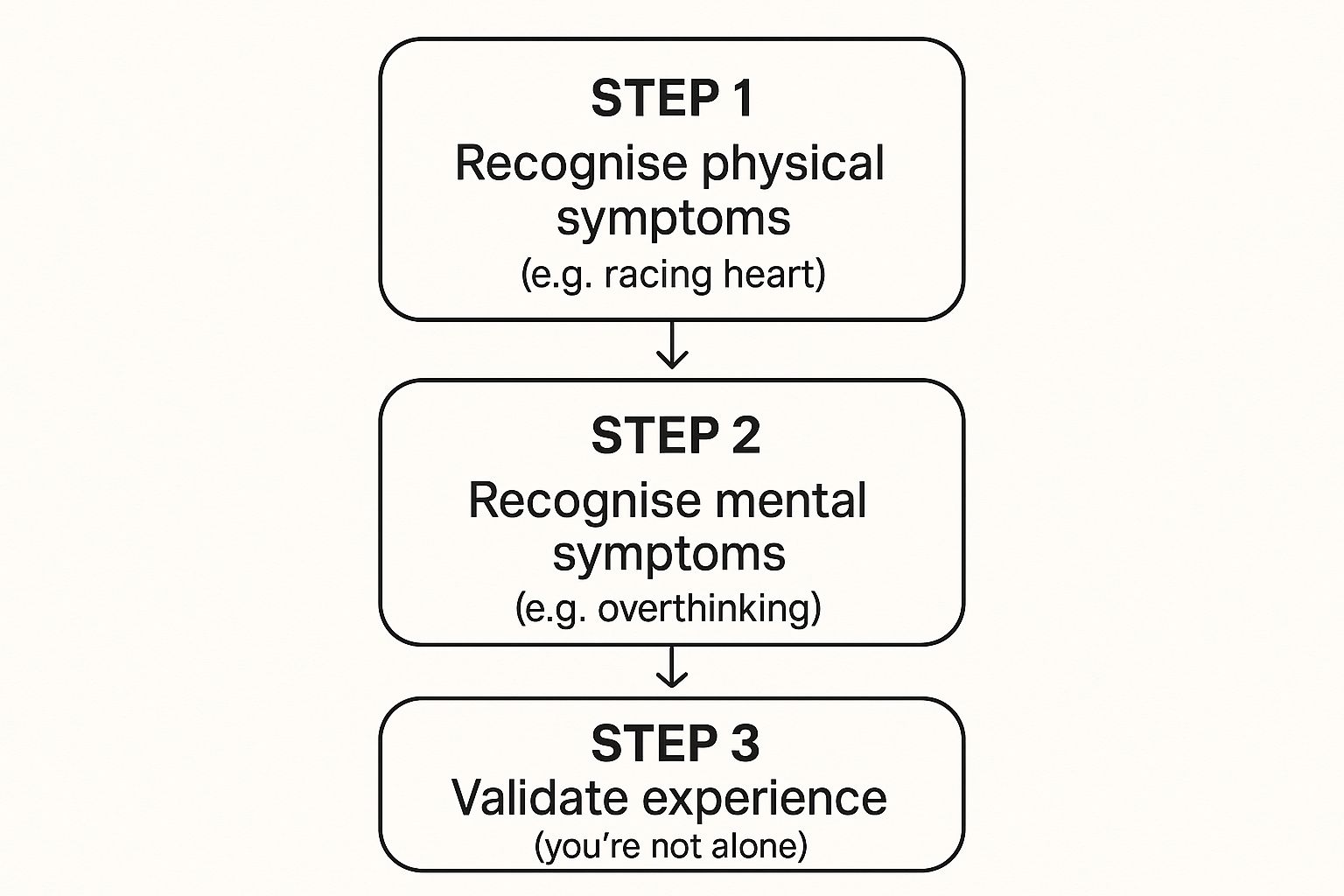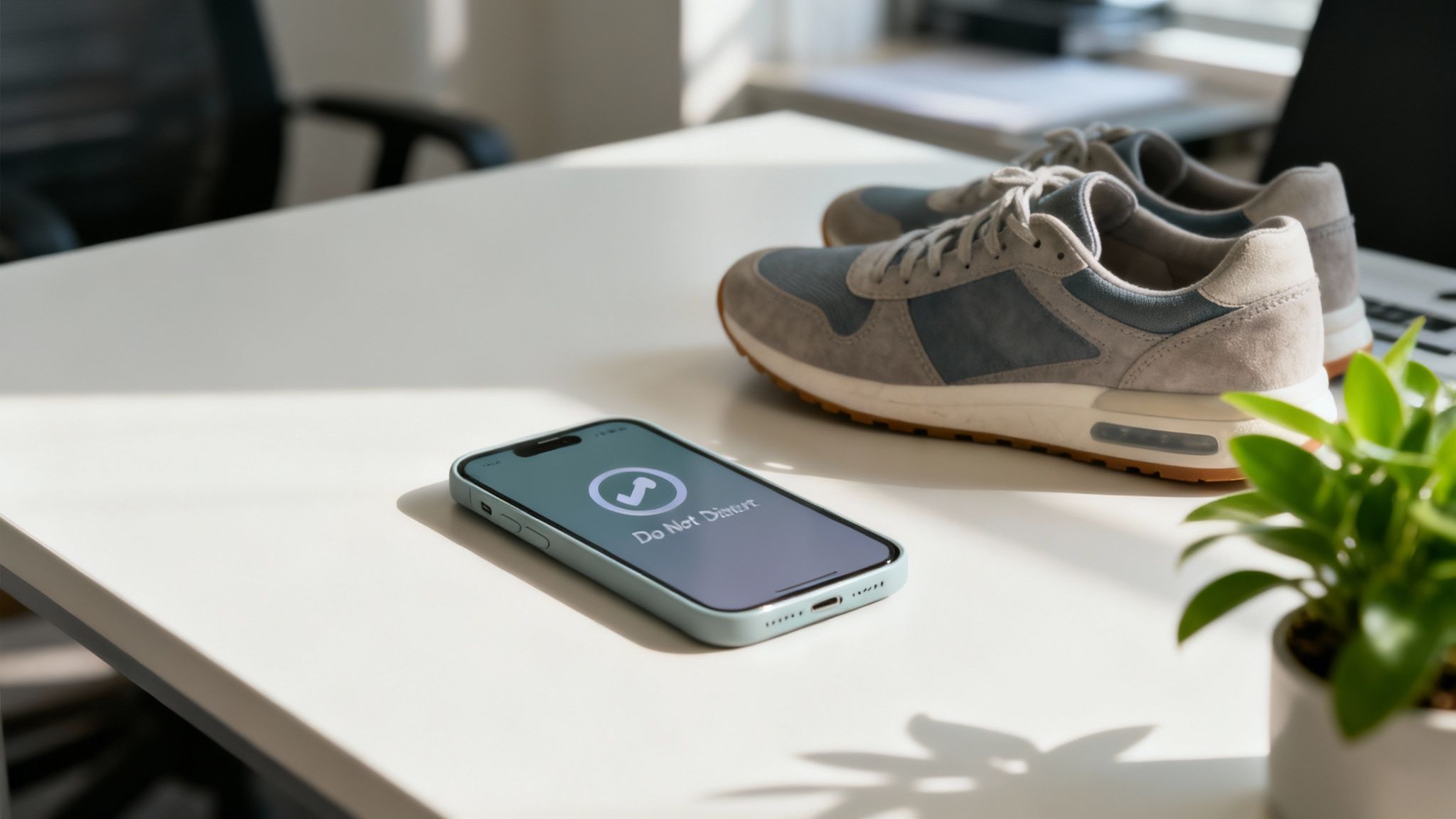How to Deal with Workplace Anxiety: Tips & Strategies
- Therapy-with-Ben
- Oct 12
- 13 min read
Updated: Oct 13
Posted by: Therapy-with-Ben
When you’re trying to deal with workplace anxiety, it’s a bit of a two-step process. First, you have to actually recognise the signs, and then you can start putting some practical coping strategies into action. The simplest way to begin is by admitting to yourself that the constant worry, the tension in your shoulders, and the non-stop overthinking are more than just 'normal stress'. They need, and deserve, your attention.
Understanding What Workplace Anxiety Really Feels Like
Let's be honest, that sense of dread creeping in on a Sunday evening or the obsessive need to re-read a simple email twenty times isn't just part of having a demanding job. It’s often the subtle, persistent hum of workplace anxiety. This feeling goes way beyond the temporary pressure of a deadline; it's a chronic state of worry and unease that can colour your entire professional life.
It can be tough to tell the difference between manageable pressure and something more consuming. Many people I work with describe it as a constant background noise—a fear of making a mistake, a preoccupation with what colleagues think, or a sense of being completely overwhelmed even when the workload isn't that bad.
If this sounds familiar, you're far from alone. The scale of this issue in the UK is staggering; projections suggest that by 2025, over half of all UK workers may experience mental health problems. In 2022/23 alone, nearly 875,000 workers suffered from work-related stress, depression, or anxiety, which led to an astonishing 17.1 million lost working days. These aren't just numbers; they show this is not just a personal struggle but a massive organisational challenge.
Recognising the Physical and Mental Signs
Anxiety doesn’t just live in your head; it makes its presence felt physically, too. That racing heart before a team meeting, the tension headaches that arrive like clockwork in the late afternoon, or that knot in your stomach when your manager's name pops up on screen are all physical signals your body is sending.
Mentally, it might look a bit like this:
Catastrophising: Immediately assuming the worst-case scenario will happen after you send a report or get some feedback.
Imposter Syndrome: A nagging feeling that you aren't qualified for your job and you'll soon be exposed as a fraud.
Avoidance: Putting off tasks that make you anxious, like making important phone calls or starting a complex project.
This infographic lays out a simple way to identify these symptoms and start validating your own feelings.

The real insight here is that you can't address what you don't acknowledge. Acknowledgement is the first step towards getting a handle on it. Learning more about **recognising the signs of mental health problems** can give you more clarity and empower you to take meaningful action.
The crucial first step is to validate your experience without judgement. Realising that what you are feeling has a name—and that you are not alone in feeling it—can be incredibly liberating. This isn't a sign of weakness; it's about recognising a manageable condition.
Practical Techniques To Manage Anxiety In The Moment

When you feel that familiar wave of anxiety creeping in during a hectic workday, you need something that works now. Not tomorrow, not after your next therapy session, but right there at your desk. The trick is to have a few simple, discreet tools you can turn to when your thoughts start to spiral out of control.
These strategies work by hitting the pause button on the anxiety cycle. They yank your focus away from whatever's fuelling the fire—be it a looming presentation or an intimidating email—and anchor you back in the present moment.
Ground Yourself with the 5-4-3-2-1 Method
One of the most powerful techniques I often share with my clients is the 5-4-3-2-1 grounding exercise. It's incredibly straightforward and forces your brain to pay attention to your immediate surroundings instead of getting lost in internal fears. Best of all, you can do it silently, wherever you are.
Just take a moment to pause and quietly identify:
Five things you can see (the bezel on your monitor, a pot plant, a pen, a colleague's colourful jumper).
Four things you can feel (the cool surface of your desk, your feet planted on the floor, the texture of your shirt).
Three things you can hear (the low hum of the office air-con, distant typing, the soft rustle of paper).
Two things you can smell (maybe the faint aroma of coffee, or the hand soap you used earlier).
One thing you can taste (the lingering flavour of your morning tea, or simply the neutral taste of your own mouth).
This sensory checklist is brilliant because it interrupts the pattern of overthinking and gives you a much-needed mental reset. It’s particularly helpful when you feel completely swamped by your to-do list or an unexpected problem throws your day off course.
Control Your Breathing with Box Breathing
Your breath is an incredibly powerful tool for calming your nervous system. When we get anxious, our breathing often becomes shallow and quick, which just tells our brain there's a threat. By deliberately slowing your breath down, you send a clear signal that the danger has passed and it's safe to relax.
Box breathing is a fantastic, discreet exercise for this. Just imagine drawing a square with your breath:
Breathe in slowly through your nose for a count of four.
Hold your breath gently for a count of four.
Exhale slowly and completely through your mouth for a count of four.
Hold again at the end of the exhale for a count of four.
Try repeating this cycle three or four times before you head into a big meeting or after a stressful conversation. Nobody will even notice you're doing it, but you'll absolutely feel the difference in your heart rate and your ability to think clearly.
This practice is a simple form of mindfulness, which is a skill you can strengthen over time. You can learn more about **what mindfulness in therapy is and how it can help** in our detailed guide.
Remember, the goal isn't to eliminate anxiety completely, but to manage it. These techniques give you the power to dial down the intensity, allowing you to think more clearly and move forward with your day.
Beyond these in-the-moment fixes, building a regular mindfulness practice can make a huge difference to your overall anxiety levels. If you're looking to build a more resilient foundation against workplace stress, you can also explore essential meditation techniques. Developing these skills helps you learn to respond thoughtfully to triggers, rather than just reacting to them.
Posted by: Therapy-with-Ben
Building Long-Term Resilience to Work Stress

While coping skills are brilliant for getting through a tough moment, the real game-changer is building up your long-term resilience. This is about moving past the quick fixes and putting sustainable habits in place that tackle the very roots of your stress at work. It's a proactive shift towards creating a professional life that feels genuinely manageable, not just one you're barely surviving.
A huge part of this shift begins with something that sounds simple but is surprisingly difficult: setting proper work-life boundaries. In our "always-on" culture, the line between the office and your living room can get incredibly blurry, keeping your nervous system on a constant, simmering high alert. Taking back your personal time isn’t lazy; it's a powerful act of self-preservation.
Creating and Defending Your Boundaries
Let's be clear: setting boundaries isn't about being difficult or dropping the ball. It’s about protecting your mental wellbeing so you can actually perform at your best when you are on the clock. It's a fundamental skill for anyone figuring out how to handle the pressures of the modern workplace.
Here are a few practical places to start:
Silence your notifications. As soon as your workday is meant to be over, mute the email and team chat apps on your phone. Seriously.
Have a shutdown ritual. This could be anything from tidying your desk to writing tomorrow’s to-do list. It's a concrete action that signals to your brain, "Okay, we're done for the day."
Practise the professional 'no'. When your plate is full, it's not just okay to decline a new task, it's necessary. A simple, "I don't have the capacity for that right now, but I could look at it next week," is both firm and collaborative.
Building resilience is like training a muscle. It requires consistent, deliberate effort, but over time, it becomes stronger, making it easier to handle the inevitable pressures of work without feeling overwhelmed.
Challenging Unhelpful Thought Patterns
So much of our anxiety isn't caused by events themselves, but by the internal stories we tell ourselves about them. This is where tools from Cognitive Behavioural Therapy (CBT) can be incredibly powerful for spotting and reframing these unhelpful thoughts.
You don't need to be a therapist to start using these ideas. The first step is just to notice the thoughts as they pop up. Do you find yourself catastrophising, where a tiny mistake spirals into a career-ending disaster in your mind? Or maybe it’s imposter syndrome, that nagging whisper telling you you’re a fraud, despite all the evidence to the contrary.
Once you’ve spotted a thought, you can start to challenge it. Ask yourself a few simple questions:
"Where's the actual evidence for this thought?"
"What's a more realistic, balanced way of seeing this situation?"
"What would I tell a good friend if they were thinking this?"
This process of questioning your automatic negative thoughts might feel a bit awkward at first, but it's a crucial step in retraining your brain to be less reactive. This work is also deeply connected to self-belief; you can explore this more in our guide on proven strategies to build self-confidence. By consistently challenging these internal narratives, you slowly strip them of their power and build a much more resilient mindset.
Posted by: Therapy-with-Ben
How to Handle Difficult Conversations and Workplace Triggers
Let’s be honest, certain work situations can feel like you’re walking through an emotional minefield. A performance review, a disagreement with a colleague, or just the sheer pressure of a looming deadline can act as massive triggers, sending your anxiety through the roof.
These moments often force us into difficult conversations—the very kind most of us would rather avoid. But learning to navigate these high-stakes interactions is a vital skill for getting a handle on workplace anxiety. This isn't about becoming more confrontational; it's about learning to communicate your needs and boundaries clearly and calmly.
Preparing for Tough Conversations
Walking into a difficult discussion unprepared is a bit like sitting an exam you haven’t revised for. It’s a recipe for anxiety and, frankly, a poor outcome. Whether you need to talk about a colleague's behaviour or ask your manager for support, a little bit of prep can make all the difference.
Before you even think about starting the conversation, take some time to get your thoughts straight. What is the one key message you absolutely have to get across? What would an ideal outcome look like? Jot down a few bullet points. They’ll be a lifesaver, keeping you on track if you start to feel overwhelmed or emotional during the chat.
It’s also incredibly helpful to try and anticipate the other person's perspective. Thinking about their point of view doesn’t mean you have to agree with it, but it helps you prepare for their likely reactions and respond thoughtfully, rather than just getting defensive.
A simple script can be your best friend in these moments. It’s not about being robotic; it's about having a clear, calm starting point when your anxiety is screaming at you to just stay quiet.
For instance, if you’re struggling and need to ask your manager for help, instead of blurting out "I can't cope," which can feel deeply vulnerable, try a more structured approach.
Something like: "I'm fully committed to getting this project over the line, but I'm finding my current workload is affecting the quality. Could we have a chat about how to reprioritise my tasks to make sure we meet the deadline successfully?"
See the difference? This reframes the entire issue from a personal failing into a collaborative, problem-solving exercise.
Navigating Feedback and De-escalating Tension
Getting critical feedback can feel like a personal attack, especially when you’re already feeling anxious. The trick is to separate the feedback from your own sense of self-worth. It’s a crucial distinction to make: feedback is about your work, not your value as a person.
When you’re on the receiving end of feedback:
Listen actively. Really listen. Don't just wait for your turn to speak or interrupt to defend yourself.
Ask clarifying questions. This shows you're engaged and helps you fully understand what's being said.
Thank them for their input. Yes, even if it’s tough to hear.
If a chat with a colleague starts getting tense, your focus needs to shift to de-escalation. Keep your voice calm and your body language open. Try using "I" statements to express how you feel without pointing the finger. For example, "I feel concerned when deadlines are missed," lands very differently than, "You always miss the deadlines."
These communication skills are vital for everyone, but particularly for younger workers who might not feel as confident speaking up. Research actually highlights how generational differences play a role in how workplace anxiety is managed here in the UK. For example, employees aged 18–24 are the most likely to be absent due to stress but are far less likely to confide in their managers compared to older colleagues. The interesting thing is, they're also the most receptive to support when it's offered. You can find more insights on this generational divide over at Mental Health UK.
Posted by: Therapy-with-Ben
Knowing When and How to Seek Further Support

Sometimes, no matter how much you focus on your breathing or how well you guard your boundaries, that feeling of being completely overwhelmed just refuses to budge. Realising that your own strategies aren't quite cutting it isn't a failure. Far from it—it’s actually a sign of incredible self-awareness and strength.
Taking that next step to seek professional support can feel like a huge leap, but it’s often the most powerful move you can make when work anxiety has its claws in you. The tricky part is knowing when it’s time to make that call.
Key Signs It’s Time for Professional Help
If you're on the fence, wondering whether you should reach out, here are a few clear indicators that your anxiety might need more structured, professional support:
Constant Impact: Is anxiety consistently getting in the way of your work? Think missed deadlines, struggling to concentrate on most days, or a noticeable dip in your performance.
Life Spillover: The stress isn't staying at the office. It's bleeding into your personal life, putting a strain on relationships or sucking the joy out of hobbies you used to love.
Physical Symptoms: You’re dealing with persistent physical issues like insomnia, constant headaches, or stomach problems that you have a nagging feeling are linked to your stress levels.
Avoidance Behaviour: You find yourself actively dodging work. This could mean calling in sick more often than you'd like, or simply feeling a debilitating sense of dread at the thought of going in.
Acknowledging you need help is the first and most courageous step. It means you are prioritising your wellbeing, which is the foundation for a sustainable and fulfilling career.
Navigating Support Systems in the UK
Once you've decided to get help, the next question is... where do you even start? In the UK, you have several clear pathways for support, and understanding them can make the whole process feel much less intimidating.
Your GP is usually the best first port of call. They can assess what's going on, chat through treatment options like therapy or medication, and refer you to local NHS mental health services. The key is to be open and honest about how work is affecting you.
Many companies also have an Occupational Health service or an Employee Assistance Programme (EAP). These are completely confidential resources set up specifically to support staff with work-related issues, including mental health.
It's also worth knowing your rights. You can request ‘reasonable adjustments’ at work under the Equality Act 2010 if your anxiety is having a long-term impact on your day-to-day life. This isn't about getting special treatment; it's about levelling the playing field. It might look like a change to your working hours, moving to a quieter desk, or having more regular check-ins with your manager.
Investing in mental wellbeing isn't just a nice-to-have for companies; it's a solid business decision. In the UK, poor mental health costs employers up to £45 billion every year in lost productivity and staff turnover. But for every £1 invested in mental health support, companies see an average return of £5. You can read more in these mental health at work statistics. Knowing this can give you a bit more confidence when talking to your employer. You aren't asking for a favour; you're suggesting a sensible adjustment that's good for both you and the business.
Posted by: Therapy-with-Ben
Common Questions About Workplace Anxiety
When you're dealing with anxiety at work, it’s completely normal for a lot of questions to bubble up. You might wonder about your rights, or whether what you're feeling is just "normal" stress. Getting some clear answers can make a huge difference, helping you feel more in control and less alone. It’s an area filled with uncertainty, so let's walk through some of the most common concerns I hear.
So many people I speak to worry about their job security if they open up about their mental health. While that fear is totally understandable, it can unfortunately stop them from getting the support they're actually entitled to.
Can I Be Dismissed for Having Anxiety in the UK?
In short, no. You can’t be dismissed just for having anxiety. If your anxiety is severe enough to be considered a disability under the Equality Act 2010, your employer legally has to make 'reasonable adjustments' to support you.
For anxiety to count as a disability in this context, it needs to have a long-term and significant negative effect on your day-to-day life. If an employer were to dismiss you for this, they could be breaking the law, and it could lead to a claim of unfair dismissal or discrimination. These protections are there to make sure you’re supported, not penalised.
What Is the Difference Between Normal Work Stress and an Anxiety Disorder?
This is a really important one to get your head around. Work stress is usually a temporary reaction to a specific challenge, like a looming deadline or a tough presentation. Once that situation is over, the stressful feeling tends to fade away.
An anxiety disorder, on the other hand, involves a persistent and excessive worry that often feels completely out of proportion to what’s actually happening. It gets in the way of your daily life, even when there isn’t an obvious stressor right in front of you. The real tell-tale signs are how long the feeling lasts and the massive impact it has on your life, well beyond the specific thing that might have triggered it.
The line is crossed when the worry doesn't switch off with the work computer. If the feeling of dread is constant and affects your ability to function, it’s likely more than just stress.
What Simple Workspace Changes Can Help Reduce Anxiety?
Creating a calmer physical space can have a surprisingly powerful effect on your mental state. You don't need to do a massive overhaul; just a few small, deliberate changes to your workspace can reduce that feeling of sensory overload and help you focus.
Declutter your desk: A tidy space really does help create a clearer, more organised mind. It just reduces the visual noise.
Bring in a plant: A bit of greenery has been shown to lower stress and lift your mood. It’s a simple but effective touch.
Manage the noise: A good pair of noise-cancelling headphones can be a lifesaver, allowing you to block out distractions and create your own little bubble of calm.
Making sure you have decent lighting and an ergonomic setup can also ease physical tension, which is often deeply tangled up with mental anxiety. These small adjustments are all about taking back a bit of control over your immediate environment.
If you're struggling to manage these feelings on your own, please know that professional support is available. At Therapy with Ben, I provide a safe space to explore these challenges and develop effective coping strategies. Find out more about how I can help at https://www.therapy-with-ben.co.uk.








Comments